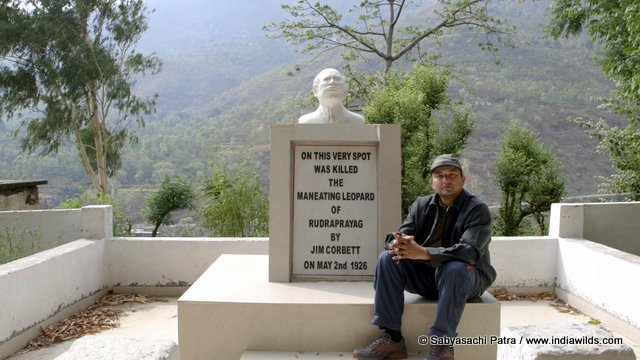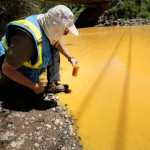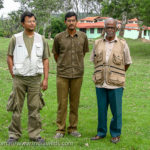IndiaWilds Newsletter Vol. 5 Issue VI
The Wrath of Rudra
You can also view our short film “Save the Himalaya” below –
I also covered some remote corners as well as tourist/pilgrim hotspots in Rudraprayag and Chamoli districts. What I saw shook me up to the core. I realised that disaster was waiting to happen.
After the initial couple of days of rains when the first landslides started, I realised that not even my 4 wheel drive Safari can negotiate the mud, rock and force of landslides to Rudraprayag and then back to Delhi. However I hadn’t realised that nature will take the ‘Rudra’ or violent form of Lord Shiva so soon.
Population Explosion in the Hills:
The number of people living in these hills has increased exponentially over the years. A decade and half back, the hamlets were smaller and at greater distances from each other. Today the population explosion has turned the hamlets into towns.
While tracing the heart-breaking story of a kid lifted by a leopard from when the kid was playing close to the mother and grandmother, I realised that there is no concept of birth control. The daily labourer – whose grandson was taken away by leopard had six children. The increase in the family size had led him to expand his house. Similarly, I found every house in the hills was being expanded. Small kids are engaged in constructing their own houses.
While speaking to the labourers and the people of the area one gets to know the ground realities. Increasing population of the villages is resulting in those becoming municipalities. And the municipalities now insist on tender process even for small work. What was supposed to enhance transparency has been exploited by a few, as the tenders are being cornered by contractors from other states as well as from Nepal. These contractors bring in migrant labour from other states – who are hard working but can’t find work in their native villages, and these migrant labourers further increase the local population and build their own shanties/houses in the hills placing tremendous pressure on this fragile ecosystem.
To make matters worse, India and China are in a race to be the first to dam all our rivers so that later on they can claim that the other had reduced the flow in the river and can go for international arbitration. There are many small and big dams in the Ganga as well as her tributaries Alaknanda, Mandakini etc. Construction of these dams lead to large contracts being awarded. The contractors bring in labourers from other states who soon settle in these hills.
Lack of Vegetation:
The hills have been completely denuded. There are very few large trees in the hills which can bind the soil. There is hardly any canopy cover to break the force of the rain and absorb it. So even the slightest of rain creates large gullies of gushing water within minutes and washes away mud and rocks downwards increasingly intensifying its power by meeting other such rivulets of water and mud torrents to become a raging landslide.
Increased construction in the hills to cater to the burgeoning population, migrants, as well as restaurants and hotels for the tourists is fracturing the rocks further and when there are rains, landslide becomes a common event. The climate of the hills has changed. These towns have become all concrete without any trees. It is so hot that majority of the hotels has either air-conditioned rooms or have made provision for air coolers. The demand for creature comforts of tourists ensures that there is lot of demand for power. The total power demand in Uttarakhand has gone up by more than thousand Mega Watt every year in the years 2006-2007, 2007-2008, 2008-2009, with the share of industries increasing due to tax holidays.
Himalaya unlike other mountains:
Our planners seem to have forgotten that Himalaya is not like other mountain ranges. Himalaya is Holy. Himalaya is the epitome of man’s quest for spirituality.
According to Hindu Mythology, the Pandava’s had prayed in these mountains. Arjuna had done penance at Tunganath and had obtained Pasupata Astra, the fabled divyastras. I was humbled to be in such holy mountains. However, looking at the plastics and other garbage dumped at 12000 feet, I realised that the pilgrims don’t think twice in desecrating these holy mountains. Nature has taken the ‘rudra rupa’ or violent form and destroyed much of these towns.
Himalaya is also a comparatively younger mountain range unlike the table top mountains in South Africa. According to geologists Himalaya is even younger than some of the rivers like Bhagirathi, Alaknanda, Bramhaputra etc. Hence these rivers cut across deep channels which developed hand-in-hand with the growth of the Himalaya. The Himalaya has risen about 5000 feet or more since the middle Pleistocene. Himalaya hasn’t yet reached its so-called maturity and some of the mountains in the Himalaya are still growing. We need to understand this and realise that these holy mountains are also structurally as well as ecologically fragile. So blasting apart these mountains to construct dams, tunnels, buildings etc is going to create large faults and weaken it structurally. In layman’s terms, it is akin to placing too much of workload on a young pace bowler which is definitely going to result in a breakdown.
The Government has to also understand that dams are not the solution because with the hills denuded, the amount of silt and mud in the rivers and rivulets is mindboggling. With such silting, the efficiency of the dams will drastically reduce. It is another matter that now most of the power generating stations in the dams at Dhauli ganga, Vishnuprayag, Srinagar etc are heavily silted and power generation operations have stopped, most likely for a few months.
The dams also restrict the flow of the rivers and this has resulted in people getting a false sense of belief that the river waters will not come up and hence they move on to colonise the flood plains. These dams store water by reducing the flow in summer and release water during heavy rains further increasing the flow. It acts like a double whammy.
I found virtually bumper to bumper traffic in the entire stretch from Rishikesh, Biyasi, Kaudiyala, Devprayag, Rudraprayag, Chamoli, Joshimath, Badrinath Route. Similar traffic was found in the Rudraprayag, Kedarnath and Tunganath route. Himalaya has no respite from the thousands of vehicles pounding on it every minute. It needs some respite. No wonder, we faced this wrath of Rudra, this massive man-induced natural calamity. When any school student can tell about Newtons law about every action has got an equal and opposite reaction, it is foolishness to expect there will be no negative impact on us due to our mindless actions.
Gohna Lake dam burst: Learning From British Era
Since Himalaya is a comparatively younger mountain range, in the past there have been huge landslides leading to devastating impact. In September 1893 there was a massive landslide resulting in the blockade of the entire bed of the Birehiganga river forming a natural lake. This incident was well tracked by in August 1894 it was predicted that the natural dam of this lake will burst. By this time this lake burst it was 11000 feet wide at the base, 2000 feet wide at the summit, and 900 feet high, and when it burst, ten billion cubic feet of water were released in the short space of six hours. So well was the bursting of the dam timed that, though the flood devastated the valley of the Ganges right down to Haridwar and swept away every bridge, only one family was lost, the members of which had returned to the danger-zone after having been forcibly removed from it (excerpt within quotes from The Man eating Leopard of Rudraprayag by Jim Corbett, page 3).
Writing about the disaster preparedness by the British for this Gohna Lake dam, F. W. Champion writes “Great apprehension was felt lest the dam should suddenly give way, resulting in a devastating flood down the Alaknanda and Ganges valleys. Elaborate precautions were taken to alleviate such a possible catastrophe. An engineer was posted to watch the rise of the water and a light telegraph line was erected to enable warning to be given of an approaching flood. The danger limits of the expected flood were demarcated, the local inhabitants in the danger zone were warned to retreat, and the bridges over the river were dismantled “(Tripwire for a Tiger” Selected works of F. W. Champion, page 159).
It is interesting to note the huge amount of silting in the Gohna lake in 11 months so that one can understand how the carrying capacity of dams goes down over a period of time. It was found next day that the level of the lake had fallen 390 feet, leaving a stretch of water 3,900 yards long with an average breadth of 400 yards. The depth near the dam was 300 feet, and the bed had already silted up about 85 feet. Immediately below the dam the flood rose 280feet, but its height rapidly decreased as the channels of the rivers which carried it off widened. At Rudraprayag, 51 miles away, the rise was 140 feet; at Beasghat, 99 miles, 88 feet; and at Hardwar, 149 miles, only II or 12 feet. (Imperial Gazetteer of India Vol. 12, page 37)
The Gohna lake dam had burst about 119 years ago in 1894. Today the communication technology is much better with mobile phones, satellite phones, internet etc. We also have remote sensing satellites with very high resolution cameras attached. Our weather scientists have many sophisticated models to predict. The difference lies in the quality of management and discipline. History has an uncanny way of repeating itself, often with disastrous consequences when the learnings like the Gohna dam burst incidents are forgotten.
Triad of Natural Calamities:
In terms of natural calamity, the Super Cyclone that devastated Odisha in 1999 was the first warning about climate change, which was ignored by us. The massive flooding of Mumbai during rains in 2005 was the second mega disaster which hit India’s financial capital and still it got ignored. The present Himalayan disaster in 2013 form the three iconic events in the last 14 years and can be interpreted as the tip of the angry Shiva’s trident. We should see this as the portents of the violent future that we are going to face due to climate change and try hard in reversing some of the impact. Else, there can be no tomorrow.
Impact of our actions as per Hindu Mythology:
We are increasing the load on mother earth. According to hindu mythology, Earth Goddess couldn’t tolerate the torture by King Vena and ran away by taking the form of a cow and cried before the sages. The sages killed King Vena. Prithu the son of King Vena then begged the Earth Goddess that without her, his subjects will die. The earth goddess had replied that her udders have been squeezed till they got sore and her back broken by the ambition of the people. This led to Prithu creating a Code of conduct for all humans based on empathy rather than exploitation for the survival of all humanity. This code of conduct was given the name ‘Dharma’ by Prithu. By this code, the earth became a cow while kings became the earth’s cowherds ensuring there was always enough milk for humans as well as the cow’s calves. For more details: http://www.indiawilds.com/diary/indiawilds-newsletter-vol-3-issue-xii/
Today the kings have made way for democratically elected Governments, military rulers, greedy corporations that are often bigger than some countries and other despots. Governance in India is done by political parties whose leaders are often corrupt and are more interested in showing each other down. Unprecedented, real estate construction has happened in Uttarakhand in the last few years, throwing all rules and caution to the winds. A lot of those have been damaged and wiped out in this recent disaster.
So what is the way forward?
Tree Plantation in the hill slopes
It appears that pilgrimage to most of these places is likely to stop for atleast a year or two. Within that time the Government has to employ the locals to plant native vegetation in the mountains. This project needs to have wildlife biologists and botanists who can provide the right guidance. This will help the local villagers to find work and also help in strengthening the hills. And if controlled pilgrimage is started after a break of atleast three years, then there would be less chance of landslides.
Road Construction:Learning from Malaysia
Countries like Malaysia too have similar landscape like us with ancient mountains and rich natural heritage. To stop landslides they have planted trees and tied wire mesh on the hill slopes to support it. To hide the ugly wire mesh they have pasted exotic lawn grass patches to beautify the landscape. They also have cut channels for flow of water from the hills which directs the water and saves the road from being washed away.
Our road builders in the hills, need to ensure that they don’t cut the mountain vertically. Rather creating a gentle slope will ensure that the mountain facing the road gets sunshine for the growth of grass and weeds to bind the soil. Also a gentle slope will ensure that the water doesn’t fall suddenly on the road from a height like a waterfall, thereby reducing the force. The roads then will not bear the brunt of the full force of the water and landslides.
Population Control
With a population of 1.2 billion and climbing up at a rapid rate, we have to put the brakes. Else there will be civil unrest.
The challenge is that the affluent segments of the society have virtually junked the one child norm. And to top it, the filmstars who have lot of fan following and are seen as trend setters, are now engaged in even “rent a womb” to have more children of their own. We cannot create atrocities like Sanjay Gandhi did in trying to forcibly operate people. However, we can provide positive motivation to people to limit themselves to a one child family. It is time Government needs to link up PDS, direct cash transfers and other benefits to families that have maximum of two children and families having one children should be given extra benefits like assured jobs. Unless the people, NGOs, women self-help groups and Government raise awareness on this aspect and work hand in hand, we are moving towards disaster.
Stop Migration of Population: Set up Workers’ Cooperatives
Migration of people from and to the hills needs to be stopped. If the NREGA projects are implemented properly and people can get minimum of 100 days plus work in their villages and if the money is directly given to them without being siphoned off, then a lot of people may not migrate out of their villages.
We are a free country and anyone can work anywhere, however, people should not be force to leave their homes just because they don’t have work close to home. In Uttarakhand and Himachal Pradesh which faced this disaster, the need of the hour is to create cooperatives for the local working class people. These cooperatives can then bid for local projects and if they win they can then employ the local labourers and working class. The Hill folk of Uttarakhand are hard working and should be able to do well provided they get a bit of help from the NGOs. This co-operative will also help in their training and skill building. One needs to see that these co-operatives have an enhanced vision unlike the traditional trade unions. This will help more of local people getting gainful employment close to their villages and will discourage employment of migrant labour from outside.
Stop Damning of Rivers
Mindless constructions of dams on rivers have to stop. At present, dams have been constructed on the same river within few kilometres of each other. The Government has to work on power generation through alternate routes. The cost of solar power has drastically come down, so there is no excuse not to pursue it. It further doesn’t have the deleterious impact of our hydel power or thermal power units.
Power supply to the villages
Drawing power lines and connecting them to the grid is again a time consuming and tough affair. The Government should take this as an opportunity and install solar power grids for individual villages which are off the main power grid making the villages self sufficient.
Construction Guidelines: Enforce River Regulation Zones
Since the construction of dams have reduced the flow of the rivers in many places, people have moved in and have constructed houses in the otherwise flood planes and high flood areas. When the flow of water increased the dams also added to the woes by releasing water and a lot of the houses and hotels were washed away. The State Governments have to implement the River Regulation Zones without diluting those. After facing such disaster, I hope for once the Chief Minister as well as his political opponents will not cave into the real estate mafia and will strictly ensure enforcement of River Regulation Zones.
The MoEF should also take note of the rampant constructions of hotels, restaurants etc for pilgrims in the Kedarnath Musk Deer Sanctuary and other forest lands without any permissions. NGOs should also protest these constructions without fear or religious bias.
Awareness Campaign for Pilgrims
The army, airforce, navy, ITBP and other paramilitary forces have done a heroic job in rescuing people. People who are old, unfit, small children and even pregnant women with advanced stage of pregnancy had visited the holy shrines and were rescued. We need to think if all the tourists should have been in those places?
According to Hindu religion, Badrinath is part of the revered Char Dham yatra. The Char Dhams or four important shrines are Puri, Rameshwaram, Dwarka and Badrinath. According to the traditions, pilgrims who undertake the char dham yatra have to start in Puri, then go to Rameshwaram and then Dwarka and finally end in Badrinath. In earlier days when the road transport was not good, a major part of the yatra to Badrinath was by foot. Since Badrinath is supposed to be the place where the pandavas left for the heavenly abode, people used to believe that they may perish while attempting the char dham yatra. People who couldn’t attempt the Char dham yatra, as it means travelling the length and breadth of this massive country, used to contain themselves visiting Badrinath, Kedarnath, Gangotri and Yamunotri as they are located in Uttrakhand. It used to be known as Chota Char dham yatra. However, in this age of false branding, the chota char dham is being branded as Char Dham and any pilgrims to Badrinath are also suggested to go to Kedarnath, Gangotri and Yamunotri. This may be good business for the local tour operators; however, it places more pressure on the infrastructure of the state.
Limit Tourist Flow
Walking the last 17 kilometer stretch to Kedarnath is no child’s play. Even though mules as well as porters are there to carry people this is increasing the potential for disaster. The Government should limit the number of pilgrims to these places as today the numbers far exceed the carrying capacity of these ecologically fragile places. The visit of pilgrims to these sites should also be regulated as is done for the Amarnath yatra.
We are becoming a huge burden on mother earth and hence have to mend our ways; else the Pralay/Armageddon/Apocalypse is not far away.
Electrocution of Wildlife: Need for underground cabling of power lines
Many times we find wildlife as large as elephants and tigers getting electrocuted by low hanging electric wires. Given this scenario, many completely ignore the birds that get electrocuted when their wings touch two wires as perhaps most of the times we see crows, despite being intelligent birds, getting electrocuted. In a series of gruesome images documented by IndiaWilds Moderator Roopak Gangadharan, the plight of bats have come to the fore.
In this country death of wildlife especially of the winged variety through electrocution, be it birds or bats, goes unnoticed and unreported. The forest department often shrug off the incident saying that it is the responsibility of the Electricity department.
In States like Odisha, due to lack of maintenance the power lines hang low and elephants routinely get electrocuted. Now the power distribution companies have refused to maintain the power lines, expressing their inability to maintain due to lack of finances. There was demand for the CAMPA funds to be diverted for this purpose, which was rightly opposed. Now the Odisha State Government has agreed to fund the maintenance of power lines to prevent further electrocution of elephants.
However, till now we haven’t examined the root cause of the issue. Electrocution of wildlife happens from the overhead power lines. This can be easily resolved if the Government/State Electricity Boards and the power companies agree to place underground power cables instead of the present system of stringing wires overhead. Normally the Utilities in India don’t like the idea of underground cables as historically we have always stringed power lines overhead and also because the cost of underground cabling is higher due to the requirement of digging. However, there are many pros and cons for underground cabling.
At present the power companies have to maintain a clear area of about 30 – 40 feet wide under the power lines and spend time, energy and money in maintaining this. In the Forest/National Park areas, it becomes a big challenge, as they have to continually clear the undergrowth. Underground cabling doesn’t require so much of clearance as the cables are bunched together. This will also help in saving a lot of money, manpower and time and it will save a lot of trees as well. In this era of climate change, this move will be really welcome.
The overhead power lines often come in contact with trees and this results in transmission loss. In India, the transmission and distribution losses are around 30% or higher. Industries, especially MNCs with factories in various countries often produce evidence that the quality of power in India is much lower than that available in other countries. It harms our industries as well as appliances in households where surge and spikes are the norm rather than exception. Underground cabling will help in not only reducing the loss of power, but also result in improving the quality of power.
During lightning, storm and cyclones this situation becomes acute and power outages happen. Underground cabling can definitely help here.
In India there is a mafia who steal the power cables and run this as a legitimate business. Underground cabling will stop this practice.
This will also tremendously enhance the aesthetics of the city and countryside.
Other Conservation News:
Pesticides in Birds
Alarming levels of pesticide residues have been found in birds. Time to change our farming practices and move to natural pesticides like neem based pesticides which have already proven their efficacy in field trials of the Ministry of Chemicals and Fertilisers.
http://www.indiawilds.com/forums/showthread.php?t=12684
Three tigers dead in Corbett
India’s one of the premier tiger reserves is facing tough times as three of its tigers have been killed within a week. We appear to be losing the war to save the tiger.
http://www.indiawilds.com/forums/showthread.php?t=12643
Arunachal Pradesh: Ziro Valley losing wildlife due to hunting
http://www.indiawilds.com/forums/showthread.php?t=12744
12407 hectares added to Point Calimere Wildlife Sanctuary
The Tamil Nadu Government has added 12407.27 hectares to the Point Calimere Wildlife Sanctuary. Well known for feral horses, this sanctuary also has blackbucks and the mudflats act as host to migratory birds in the winters. It faces challenges from industries who have converted the mud flats to salt pans. http://www.indiawilds.com/forums/showthread.php?t=12680
Gharial Population increase in Chambal river
The Gharial population in Chambal is estimated to have increased to 785 from the low 300s three years back.
http://www.indiawilds.com/forums/showthread.php?t=12689
Natural History
Country Notebook by M Krishnan
http://www.indiawilds.com/forums/showpost.php?p=61400&postcount=59
Image of the Month
The honour for the image of the Month for May 2013 goes to Kaleeswara Srikanth –
http://www.indiawilds.com/forums/showthread.php?p=61732
Wildlife Photography:
Some of the wildlife images shared by IndiaWilds Members:
Elephants at Kaziranga by Mrudul Godbole
http://www.indiawilds.com/forums/showthread.php?t=12597
Leopard at Kabini by Kaleeswara Srikanth
http://www.indiawilds.com/forums/showthread.php?t=12575
Malabar Giant Squirrel by Sucheth Lingachar
http://www.indiawilds.com/forums/showthread.php?t=12601
Malabar Trogon by Divyang Dave
http://www.indiawilds.com/forums/showthread.php?t=12662
Brown Hawk Owl by Bibhav Behera
http://www.indiawilds.com/forums/showthread.php?t=12632
Spotted Owlets by Anand Madabhushi
http://www.indiawilds.com/forums/showthread.php?t=12624
White rumped vultures from Pench by Pralay Lahiri
http://www.indiawilds.com/forums/showthread.php?t=12616
Greater Flamingo by Jitendra Katre
http://www.indiawilds.com/forums/showthread.php?t=12559
Tussar Silk moth by Kaling Dai
http://www.indiawilds.com/forums/showthread.php?t=12670
Hover fly by Jitendra Katre
http://www.indiawilds.com/forums/showthread.php?t=12673
Owl Moth by Abhirup Dutta Gupta
http://www.indiawilds.com/forums/showthread.php?t=12678
Regards,
Sabyasachi Patra
Please post your views and feedback in the comments below.
- Canon Launches Cine Servo 11-55 mm T2.95-3.95 lens - 10 September,2025
- Water Monitor Lizard in Sundarbans - 14 May,2025
- Radio collared Tigress - 30 January,2025
















An indepth article, Sabyasachi! It was shocking to see the scale of the tragedy that unfolded in these mountains. I never went up to the higher reaches of Uttarakhand but did make a trip to Nainital and Corbett a couple of years back. It is stunning the loss of tree cover and the extensive house building in the mountains. And your point about population control is very valid. We might indeed see civil unrest in the years to come.
Thanks Rachna,
You should visit other places in Uttarakhand. The smaller and less crowded places are beautiful. I don’t know how we can control the population challenge, as I hardly see people talking about it.
Cheers,
Sabyasachi
I’m so glad to have discovered your website. Thank you for your profound insights into the plight of the Himalaya and the underlying causes contributing to the disaster in Uttarakhand — and for your awareness of the spiritual truths revealed in the ancient texts, but so often forgotten or dismissed. Yours is a voice of consciousness, much needed in a dark age, when we are destroying the earth.